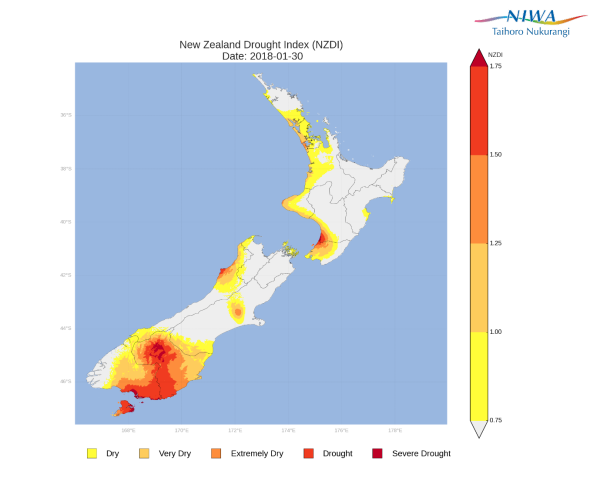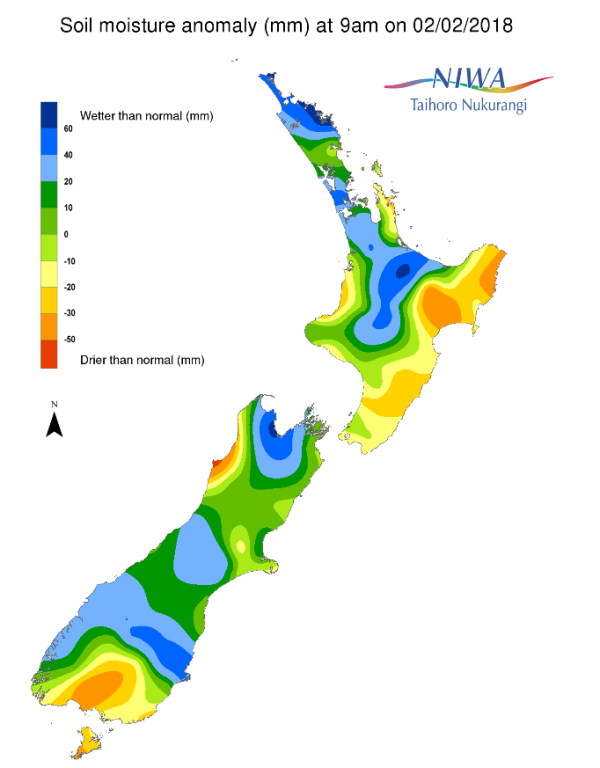A weekly update describing soil moisture across the country to help assess whether severely to extremely dry conditions are occurring or imminent. Regions experiencing these soil moisture deficits are deemed “hotspots”. Persistent hotspot regions have the potential to develop into drought.
Facts: Soil Moisture
Across the North Island, soil moisture levels generally increased in northern areas while decreasing at least slightly in eastern and southern regions. The largest increases were observed across Auckland, northern Waikato, and western Bay of Plenty, while small decreases occurred across much of the east coast from Gisborne south to Wairarapa, as well as the Coromandel Peninsula. The driest soils compared to normal for this time of the year are found in coastal Gisborne and Wairoa, while the wettest soils for this time of the year are located in the eastern Far North District and western Bay of Plenty.
North Island hotspots continue to be found across much of Gisborne, northern Hawke’s Bay, and Tararua west to Horowhenua and Kapiti Coast. A small hotspot has also emerged across the east coast of the Coromandel Peninsula.
In the South Island, significant increases in soil moisture levels occurred across much of the West Coast, Fiordland, Otago, Southland, and southern Canterbury on 1st February due to the landfall of ex-Tropical Cyclone Fehi, which produced more than 100 mm of rainfall in some locations. However, little change was observed in northeastern portions of the South Island where rainfall amounts were significantly less. The driest soils compared to normal for this time of the year are found near Westport in Buller District, while the wettest soils for this time of the year are located near Nelson.
The only hotspot in the South Island continues to be located in Southland, but it has decreased significantly in size and strength due to the recent heavy rainfall.
The New Zealand Drought Index (NZDI) shows continued improvement in meteorological drought conditions across the lower North Island and Buller District, where drought areas have shrunken considerably in recent weeks. While meteorological drought continues across interior and southern Otago and eastern Southland, recent heavy rainfall should bring at least moderate improvement to those areas.
Outlook and Soil Moisture
In the North Island, the upcoming weekend (3rd-4th February) will feature mostly dry weather for central and southern areas. However, a few showers could deliver up to 10 mm to Hawke’s Bay and Gisborne, while a small disturbance could produce 15-25 mm for parts of Auckland and Northland. On Monday a weak front may bring 10-15 mm to parts of the central North Island before mostly dry weather arrives for Tuesday and Wednesday. By Thursday (8th February), low pressure north of Cape Reinga could bring more moderate rainfall to Northland and Auckland in the range of 10-20 mm.
With potentially significant rainfall expected in Northland and Auckland during the next week, soil moisture increases are likely to occur. Smaller increases may also occur in Gisborne and Hawke’s Bay, which would provide some improvements to the hotspots there. However, generally light rainfall is anticipated in the lower North Island, which could strengthen the hotspot from Tararua to Kapiti Coast.
In the South Island, primarily dry weather is expected over the weekend, with the exception of up to 25 mm of rainfall possible in the northern West Coast on Sunday (4th February). A passing front on Monday could produce up to 40 mm along the West Coast with up to 15 mm in the lower South Island. However, between Tuesday and Thursday high pressure will produce mostly if not entirely dry weather. In the northeastern South Island and interior Otago, weekly rainfall amounts may be less than 15 mm.
Further increases in soil moisture levels are likely in much of the West Coast during the next week due to the expected rainfall. However, soils are likely to become drier in the northeastern South Island and in interior Otago due to light rainfall there. In Southland, the ongoing hotspot may not change significantly during the next week.
Background:
Hotspot Watch: a weekly advisory service for New Zealand media. It provides soil moisture and precipitation measurements around the country to help assess whether extremely dry conditions are imminent.
Soil moisture deficit: the amount of water needed to bring the soil moisture content back to field capacity, which is the maximum amount of water the soil can hold.
Soil moisture anomaly: the difference between the historical normal soil moisture deficit (or surplus) for a given time of year and actual soil moisture deficits.
Definitions: “Extremely” and “severely” dry soils are based on a combination of the current soil moisture status and the difference from normal soil moisture (see soil moisture maps)



